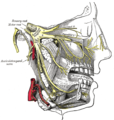The zygomatic nerve is a branch of the maxillary nerve (itself a branch of the trigeminal nerve (CN V)). It arises in the pterygopalatine fossa and enters the orbit through the inferior orbital fissure before dividing into its two terminal branches: the zygomaticotemporal nerve and zygomaticofacial nerve.
Through its branches, the zygomatic nerve provides sensory invervation to skin over the zygomatic bone and the temporal bone. It also carries post-ganglionic parasympathetic axons to the lacrimal gland.
It may be blocked by anaesthetising the maxillary nerve.
Structure
Origin
The zygomatic nerve is a branch of the maxillary nerve (CN V2).[1][2] It arises at the pterygopalatine ganglion.[1]
Course
It exits from the pterygopalatine fossa through the inferior orbital fissure to enter the orbit.[1][3] In the orbit, it travels anteriorly along its lateral wall.[3]
Branches
Soon after the zygomatic nerve enters the orbit, it divides into its branches. These include:
- Zygomaticotemporal nerve[1]
- Zygomaticofacial nerve[1]
- A communicating branch to lacrimal nerve[1]
Variation
Sometimes, the zygomatic nerve does not branch within the orbit. Instead, it enters a single foramen in the zygomatic bone called the zygomatico-orbital foramen. In this case, it divides within the bone into the zygomaticotemporal nerve and the zygomaticofacial nerve.[4]
Function
The terminal branches of the zygomatic nerve contain sensory axons.[1] These provide sensation to the skin over the temporal bone and the zygomatic bone.[4]
The zygomatic nerve also carries postganglionic parasympathetic axons.[1] These axons have their cell bodies in the pterygopalatine ganglion. They travel from the ganglion to the zygomatic nerve, and then to the lacrimal nerve through a communicating branch. From the lacrimal nerve, they enter the lacrimal gland and provide secretomotor supply.[5]
Clinical significance
The zygomatic nerve can be blocked indirectly by anaesthetising the maxillary nerve (CN V2).[2] The zygomatic nerve and its branches may be damaged by a fracture to the zygomatic bone.[6]
Additional images
-
The nerves of the scalp, face, and side of neck.
-
Branches of the trigeminal nerve. The zygomatic nerve is visible branching from the maxillary nerve and entering the orbit.
References
- ^ a b c d e f g h Rea, Paul (2016). "2 - Head". Essential Clinically Applied Anatomy of the Peripheral Nervous System in the Head and Neck. Academic Press. pp. 21–130. doi:10.1016/B978-0-12-803633-4.00002-8. ISBN 978-0-12-803633-4.
- ^ a b Pai, Umeshraya T.; Nayak, Rajeshri; Molloy, Robert E. (2005). "72 - Head and Neck Blocks". Essentials of Pain Medicine and Regional Anesthesia (2nd ed.). Churchill Livingstone. pp. 598–606. doi:10.1016/B978-0-443-06651-1.50076-9. ISBN 978-0-443-06651-1.
- ^ a b Forrester, John V.; Dick, Andrew D.; McMenamin, Paul G.; Roberts, Fiona; Pearlman, Eric (2016). "1 - Anatomy of the eye and orbit". The Eye - Basic Sciences in Practice (4th ed.). Saunders. pp. 1–102. doi:10.1016/B978-0-7020-5554-6.00001-0. ISBN 978-0-7020-5554-6.
- ^ a b Standring, Susan, ed. (2016). Gray's anatomy : the anatomical basis of clinical practice (41 ed.). Philadelphia: Elsevier. ISBN 978-0-7020-5230-9. OCLC 920806541.
- ^ Anderson, B. C.; McLoon, L. K. (2010). "Cranial Nerves and Autonomic Innervation in the Orbit". Encyclopedia of the Eye. Academic Press. pp. 537–548. doi:10.1016/B978-0-12-374203-2.00285-2. ISBN 978-0-12-374203-2.
- ^ Gellrich, Nils-Claudius Bernhard; Zimmerer, Rüdiger M. (2017). "7 - Surgical Management of Maxillary and Zygomatic Fractures". Maxillofacial Surgery. Vol. 1 (3rd ed.). Churchill Livingstone. pp. 93–132. doi:10.1016/B978-0-7020-6056-4.00007-1. ISBN 978-0-7020-6056-4.




Recent Comments